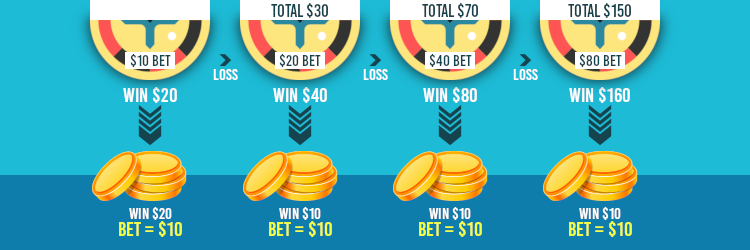
We here at Roulette69.com are devoted to explaining every Roulette tactic there is, so as to facilitate your own selection. As a Roulette player, you must have expressed the need for a method of playing.
So far, we have covered a few:
And today we are moving onto progressions. The first on our agenda is the infamous negative progression.
Why So Negative?
Negative progression is one of the most widespread gambling strategies in about any game. Whether it is the best for you profile, you will see in the following lines. Much like any other approach, it will not work for everyone. You have been warned.
First things first, let’s clarify what we mean by “progression”. In terms of Roulette, it refers to a consecutive increase of bets by a single player.
As for its negative version, it relies on hope, more or less. Opting for this approach, you need to increase your bet after generating a loss. Then you basically expect the doubled amount to bring you the quantity you had lost, bringing you to a neutral position. Therefore, this method is quite a dangerous one, and it could lead the player to losing their whole bankroll if they get a bit too carried away.
Regrettably, no one can tell you when the streak will end. That is why implementing negative progression can be hazardous. It is linked with the “gambler’s fallacy” to an extent, as it can trick you into believing that the win is right around the corner. Stay on the safe side and think rationally.
Nevertheless, the trick is to know when to stop. Practice does make perfect, and thanks to many software suppliers, you can play demo versions of online roulette for free. This way you are able to exercise this strategy before losing any money for real.
Types of Negative Progressions
There are dozens of various approaches that combined with negative progression crate a unique tactic. We have selected the most popular quartet:
- Fibonacci System
- D’Alembert System
- Labouchere System
- Martingale System
Fibonacci System
The first use of the popular mathematical formula dates back to the era of Indian Sanskrit. The sequence of numbers commences with 0 and 1. Then each next digit equals the sum of the two previous ones. Ultimately, the succession is as follows: 0, 1, 1, 2, 3, 5, 8, 13, 21, 34, 55, 89, 144, …
D’Alembert System
We are transitioning onto a slightly simpler system. In comparison with all other strategies, with D’Alembert the stakes are increased noticeably more slowly. That gives you some extra control and time to think, and rethink your decision, but there’s a small flip side. Namely, the losses are recovered just as gradually as well, so be careful.
Labouchere System
On the opposite side of the spectrum we find the Labouchere. Prevalent compared to the others on our list, the Labouchere System is centred on the player recovering several consecutive losses with a smaller number of winnings generated. In other words, it is based on recovering several losses with multiple wins.
Martingale System
Finally, the Martingale negative progression method is just as old as the Fibonacci. It is also the easiest one to master, so consider it if you are just starting with negative progression. Simply put, it is focused on a theory that there is a low probability that the player will lose a large number of consecutive bets. Its simplicity, however, does not guarantee winning using it, so again, be cautious.
Little Heads Up
Studies have shown that seasoned players go for this tactic more often than beginners. It is largely because it takes a certain amount of experience to be able to grasp the concept. It is a complex idea that takes a lot of self-discipline and control to master. In order to avoid foolish play, make sure to gain adequate and complete understanding of it before applying it to your gameplay.
The Dr Jekyll to Negative Progression’s Mr. Hyde is Positive Progression. More about it in the next blog post.
